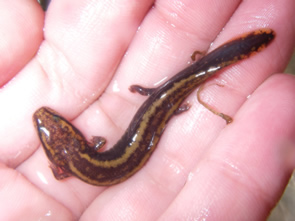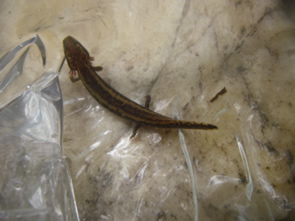
Necturus maculosus
Photo by Kristen Cecala
Description: The mudpuppy is a robust aquatic salamander, usually dark brown or gray, with irregular dark blotches down the entire body and a spotted belly. Dark coloring on the face is usually present from the nostril to the gill. They have large, feathery gills with deep red coloring and a flattened tail. The Red River subspecies can be distinguished from others by a dark line down the back and the absence of spots on the belly. Larvae have a dark line down the back bordered by yellow stripes. The Black Warrior River waterdog has a similar geographic distribution to the mudpuppy but can be distinguished by the absence of blotches on the back, darker and more reddish coloring, and a gray belly lacking spots.
Habitat/Range: Mudpuppies occupy Kentucky, southwestern Virginia, Tennessee, western North Carolina, northern Alabama and Georgia, Mississippi, and northern Louisiana. The Red River subspecies can be found from north-central Louisiana (west of the Mississippi River) to southeastern Kansas. Various bodies of water are suitable mudpuppy habitat – lakes and ponds, streams and rivers, ditches and reservoirs – but they generally prefer waters with high oxygen content. Juveniles will inhabit waters with high amounts of organic matter.
Diet: They have a very broad diet and are only limited by the extent of their gape in what they will consume. Crayfish, small fish, and invertebrates are common, as well as other salamanders, small turtles, and the eggs of fish and other mudpuppies.
Reproduction: Courtship consists of males waiting for females in shallow water and coaxing the female to move her cloaca over a sperm packet (spermatophore) deposited on the substrate. This is most likely to occur from fall to early spring. The female deposits her eggs on the bottom of an appropriate hiding place – a rock outcropping, log, or similar structure – in water less than two feet deep. Females will sometimes guard the eggs during this time. Early summer sees the eggs hatching and the hatchlings remain in the nesting area for 6-8 weeks to absorb the external yolk sac. The hatchlings often leave the nest chamber in August.

The shaded region represents the range of the mudpuppy in North Carolina.


Photo by Kristen Cecala
